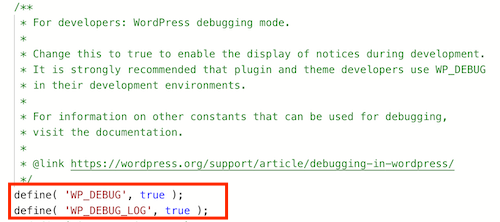啟用 WordPress 偵錯模式,以便顯示錯誤資訊
WordPress 設有特定的偵錯系統,且其核心、外掛程式、主題等內容的程式碼皆遵守標準規格,以便簡化偵測 PHP 錯誤的過程。啟用此偵錯模式後,系統即會顯示所有 PHP 錯誤及警告,您可以藉此掌握網站發生的問題。
須注意事項:若要完成以下步驟,您將需使用下列內容:
- 可存取網站檔案的 FTP 用戶端。市面上有多種第三方 FTP 用戶端可供選擇,我們推薦您使用 Filezilla FTP 用戶端。
- 可變更檔案必要內容的文字編輯器。市面上有多種第三方文字編輯器可供選擇,我們推薦您使用 Notepad++。請勿使用 Microsoft Word 等文書處理應用程式進行編輯。
- 使用 FTP 用戶端連線,或使用檔案管理程式編輯您網站的 wp-config.php。
- 將
WP_DEBUG由 false 變更為 true:define( 'WP_DEBUG', false );
啟用偵錯時:define( 'WP_DEBUG', true );
- 在以下行中,輸入:
define( 'WP_DEBUG_LOG', true );

- 變更內容完畢後,請儲存檔案。如果您使用 FileZilla,請接受 FileZilla 提出的警告並替換檔案。
- 使用網際網路瀏覽器進入您的網站,以便讓偵錯記錄儲存錯誤內容。
- 使用同一款編輯器開啟步驟 5 所建立的
/wp-content/debug.log檔案。 - 檢閱偵錯記錄的內容,找出特定外掛程式、主題的問題,或可能導致問題的設定選項。
警告:疑難排解完畢後,請務必停用偵錯模式。如果您持續啟用偵錯模式,可能會造成網站的安全性問題。